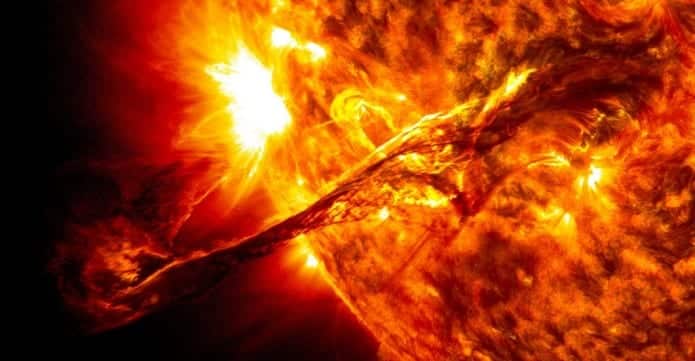New tool can predict Solar storms a day before and safeguard crucial electronic systems on the Earth from the coronal mass ejections (CMEs).
An Indian-origin scientist has built a novel tool that can predict large solar storms more than 24 hours in advance and save systems on the Earth from the coronal mass ejections (CMEs).
Developed by Neel Savani, visiting researcher at Imperial College London and space scientist at NASA, the new measurement and modelling tool takes a closer look at where mass ejections originate from on the Sun and makes use of a range of observatories to track and model the evolution of the cloud.
Solar storms start their lives as fierce explosions from the Sun’s surface. They’re made up of energetic charged particles wrapped in a complex magnetic cloud. As they explode from the sun’s surface, they can shoot out into interplanetary space at speeds of up to 3,000 kilometers per second (that’s 6.7 million miles per hour). Depending on their direction of travel, these energetic storms can journey past Earth and other planets.
If a solar storm makes it to Earth, it can interrupt the working of a variety of modern technologies including GPS and high-frequency communications, and even power grids on the ground, causing radio blackouts and citywide loss of power. It can also cause destruction within the aviation industry by disrupting communication methods.
To control related potential economic losses, affected industries have been seeking a solution that can provide them with at least 24 hours of caution. With enough lead time, they can safely change their operational procedures. For example, passenger planes can be re-routed or power grid transformers can begin the slow process of “winding down,” all of which require at least a day’s notice. “By building on earlier research, my colleagues and I have come up with a technique we think can meet that 24-hour warning goal,” Savani explained.
The strength with which a solar storm can affect our everyday technological infrastructure depends largely on the direction of its magnetic field. Often the magnetic field within a solar storm has a helical structure, twisted like a corkscrew. But, much like tornadoes on Earth, these solar storms undergo major changes during their evolution.
With a specific field orientation, the floodgates open, allowing the solar particles to enter the otherwise protective bubble of Earth’s atmosphere (the magnetosphere). This interaction between the solar material and Earth’s magnetosphere is predominately driven by a process of joining each other’s magnetic fields together. This interaction is called magnetic reconnection.
This realignment of the field works in a similar way as two bar magnets attracting. If similar poles of each magnet (north and north) are brought together, the field lines repel each other. If the poles are unlike, in our case between the solar storm and the Earth’s magnetosphere, they become magnetically connected. This new connectivity of the Earth’s magnetosphere now contains the trapped energetic particles that were previously secluded in the solar storm. If a large penetration of energetic particles makes it into the Earth’s upper atmosphere, the reaction provides the visual extravaganza that’s often called the Northern Lights.
As of today’s date, predicting the magnetic field structure within solar storms hitting Earth has remained mysterious. Modern forecasting centers around the world, such as at National Oceanic and Atmospheric Administration (NOAA) and UK Met Office, are dependent on direct measurements from inside the solar storm by a spacecraft just in front of Earth (for instance, the newly unveiled DSCOVR satellite by NOAA). Measurements tell us the direction of a solar storm’s magnetic field and thus whether it’s liable to reconnect with the Earth’s magnetosphere in a dangerous way for our technology. We’ve been stuck with less than 60 minutes of advance warning.
Getting a better handle on the origin of these solar storms is a significant step toward predicting how the storm can affect us on Earth, and to what extent. Our method relies on correctly modifying a previous forecast about how the motions of solar plasma (of mostly hydrogen ions) and magnetic field hidden below the sun’s surface can affect the initial structure of a solar storm. It’s called the solar dynamo process. This is a physical process that is believed to generate the sun’s magnetic field. It’s the engine and energy source driving all observed solar activity that includes sunspots and long-term solar variability as well as solar storms.
Triangulating the entire solar storm by using cameras at three locations from NASA’s STEREO and SOHO spacecraft in interplanetary space, using modern modeling techniques we’ve developed, enables a more robust prediction system. Since these cameras are located at very different vantage points in space, we can use them in conjunction to improve our estimations of the total shape and location of the solar storm much like the depth of field we achieve by seeing the world through two eyes.
This new predictive technique has been tested on eight different solar storms, with the first forecasts showing significant agreement with the real data. Further advanced statistical testing with a larger number of storms is now under way within NASA Goddard’s Community Coordinated Modeling Center.
Antti Pulkkinen, director of Space Weather Research Center at NASA Goddard and a coauthor of the publication said ““We’ll test the model against a variety of historical events. We’ll also see how well it works on any event we observe over the next year. In the end, we’ll be able to provide tangible information about how reliable a prediction tool it is.”
If further testing at NASA supports these initial results, the system could soon be used by the National Oceanic and Atmospheric Administration (NOAA) in the US and the Met Office in the UK for geomagnetic storm predictions.
The paper appeared in the journal Space Weather.

